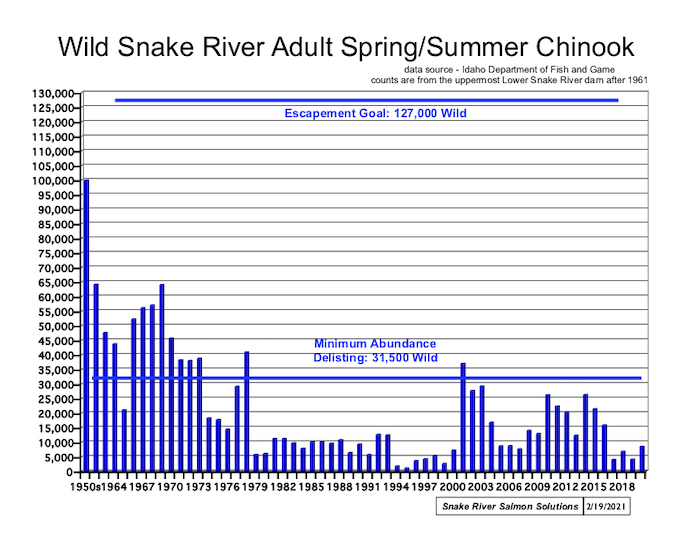forum
library
tutorial
contact

Improving Fish Numbers
Take Pressure Off Dams
by Editorial Board
Tri-City Herald, June 23, 2021
|
the film forum library tutorial contact |

|
Improving Fish Numbers
by Editorial Board
|
It sure is better to see an "up" arrow on the graph for salmon runs instead of one pointing down.

The spring chinook salmon run on the Snake River has exceeded expectations, with the number of returning fish increasing for the second year in a row.
Add that good news to the fact that there are three new healthy calves in the Southern Resident orca pod of Puget Sound, and 2021 is shaping up to be a very encouraging year.
Of course, these positive developments don't mean Washington state leaders can let up on salmon recovery efforts. But it sure is better to see an "up" arrow on the graph for salmon runs instead of one pointing down.
And key for the Tri-Cities, the improved salmon numbers also indicate that the removal of the four lower Snake River dams shouldn't be considered the end-all solution to bringing more salmon back to Washington and Idaho waters.
Although, the battle over the dams will rage on, no doubt.
The belief that breaching them is the most certain way to recover Northwest salmon and steelhead is strong among many environmental groups and others who are bent on seeing the dams breached or removed altogether.
But federal studies have shown time and again that breaching the dams would help improve salmon runs only slightly.
Ocean conditions play a huge role in the health of salmon and orcas, and there are other efforts -- like culvert repair and replacement, and habitat restoration in Puget Sound -- that can make a significant difference.
On June 17, the last of the spring chinook salmon passed through Lower Granite Dam on the Snake River, finishing up their run. The final count was 29,634, which is 27 percent more than 2020 returns and 55 percent more than 2019 returns.
Todd Myers, environmental director for the Washington Policy Center, said that the count is only 495 chinook short of the 2020 spring and summer run combined, which will end in mid-August.
Myers told the Herald that the Idaho Department of Fish and Wildlife is also tracking the salmon run and trends there look the same.
Washington state Republican Reps. Dan Newhouse and Cathy McMorris Rodgers released a statement about the promising salmon numbers, saying they demonstrate that "we are making real strides with our current mitigation efforts."
They also said, "Despite radical environmental groups trying to paint a dire picture of extinction, spring chinook returns are trending in the right direction for a second year in a row, proving what we already know: dams and salmon can -- and do -- co-exist. This year's significant return increase builds on progress we made last year and is a strong rebuke of hydropower opponents."
Earlier this year, Congressman Mike Simpson, a Republican representing the eastern side of Idaho, released a $33 billion federal plan to shut down the Snake River dams but also compensate communities and farmers in the region for the loss of electricity, irrigation and barge service that the dams provide.
While we disagree with Simpson's goal to do away with the dams, we were grateful that his proposal acknowledged their contribution to the region, as well as the massive financial losses that would occur if they were no longer in use.
His plan was a great counter to arguments made by anti-dam activists from other parts of the Northwest who believe the Snake River dams serve little purpose, and who dismiss how critical they are to eastern Washington.
For one thing, the four lower Snake dams provide reliable and available electricity at the flip of a switch.
As it happens, the Bonneville Power Administration just released an assessment of energy demand between December and March, calling the Snake dams "winter workhorses" that picked up the slack when there was an equipment failure at Chief Joseph Dam on the Columbia River. Their use as a quick backup power supply is invaluable.
For now, it appears Simpson's $33 billion proposal does not have the support needed to be included in President Joe Biden's infrastructure package. U.S. Sens. Patty Murray and Maria Cantwell, D-Wash., and Gov. Jay Inslee are not in favor of it, and even some environmental groups opposed it.
So state and national leaders should continue to focus on other salmon recovery efforts already underway.
Fish runs are improving, despite the dams, and that's encouraging. The region needs to figure out what's helping and then keep it up.
learn more on topics covered in the film
see the video
read the script
learn the songs
discussion forum
